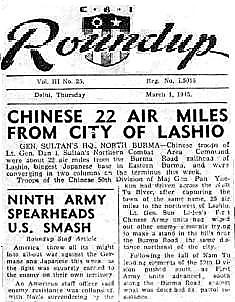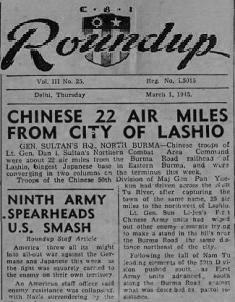
|
At right is a photo from A Tribute To My Dad showing my father in Assam, India, relaxing with a beer, but what is he reading?

|
Roundup of course! The image above is an upside down closeup from the picture at right. Although the image is blurry, the distinctive
Behind the Roundup Web Pages
The technology exists to simply scan an original and publish it to a web page. When the original (document, booklet, photo, etc.) is in good condition, this is fairly easy to accomplish. But what about when the original is yellowed, faded, and torn? The technology also captures each imperfection. The resulting page would be hard to read, no matter how large it was presented.
 A photograph of the front page of the November 30, 1944 issue of Roundup.
CLICK HERE to view the entire page in full screen.
CLICK HERE to view a readable-sized portion of the page.
CLICK HERE to view the Internet version.
A photograph of the front page of the November 30, 1944 issue of Roundup.
CLICK HERE to view the entire page in full screen.
CLICK HERE to view a readable-sized portion of the page.
CLICK HERE to view the Internet version.
|
I have adapted many original publications into web pages. While each presents its own unique challenge, they all share the above mentioned shortcomings. I decided the best way to present the original is to recreate it for the computer screen while trying to retain the look and "feel" of the original.
Imagine reading your favorite newspaper on this computer screen. Your fingers would be busier than your eyes, moving the page up and down, left and right, to read a complete story. Then there is the problem created by "Continued on page...." The newspaper is designed to be held in your hands and read. You can easily move the paper to read a story in an individual column, or open up the paper and glance at two pages at once. The headlines catch your eye and you move the paper to the story you want to read.
The computer screen is different. While the newspaper is taller than it is wide, the computer screen is wider than it is tall. What you have then is two rectangular formats, one vertical and one horizontal. In computer "lingo" these are identified as portrait (image taller than it is wide) and landscape (image wider than it is tall). The computer screen favors the landscape format since it is wider than it is tall.
So rather than trying to copy the original Roundup, I decided to recreate it. What I do is retype each story. I try to closely match the original headline type using fonts available on the computer. I scan the original photos from the newspaper and then use some basic software to enhance them. This basically involves removing the (yellow) color and adjusting the brightness of the image. Of course the images are grainy and rather poor, but still show what was originally intended.
The recreated paper is more easily readable on the computer. Everything flows down from the masthead of the paper to each story and photo. Scrolling down is all that is required. there is no need to move back and forth or up and down to read an individual story in a small column.
The stories are exactly as written by Roundup's staff or contributors. Each web page contains a bit of the history of the CBI Theater, as it was written over sixty years ago. While Roundup contained news of all theaters of the war, as well as sports and news from the home front, the web pages contain mostly stories from the CBI Theater, with a few interesting "bits" of information also published in Roundup.
 Original CBI Newspaper
Original CBI Newspaper This scanned image shows what the yellowed 60+ year old original looks like today.
This scanned image shows what the yellowed 60+ year old original looks like today.
 The color is removed creating a gray-scale (black & white) image.
The color is removed creating a gray-scale (black & white) image.

